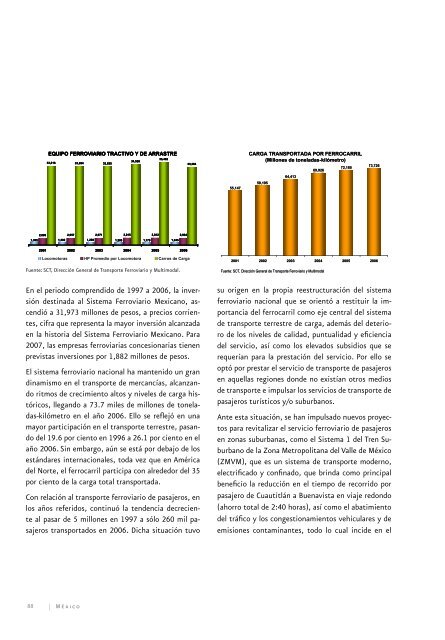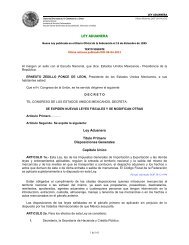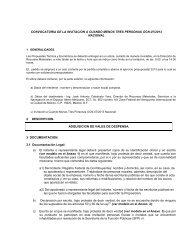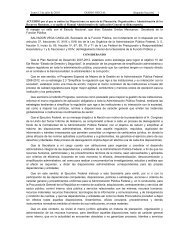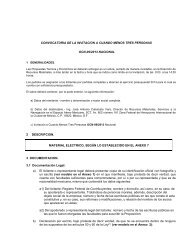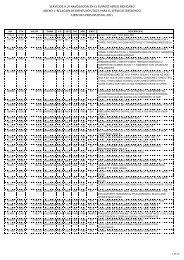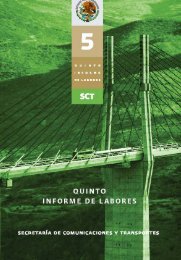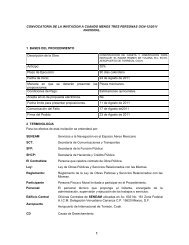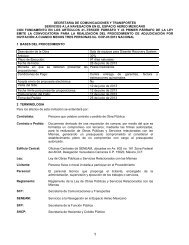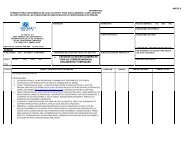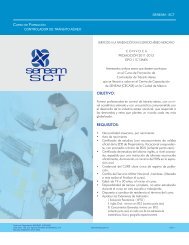Programa Sectorial de Comunicaciones y Transportes 2007 - Seneam
Programa Sectorial de Comunicaciones y Transportes 2007 - Seneam
Programa Sectorial de Comunicaciones y Transportes 2007 - Seneam
Create successful ePaper yourself
Turn your PDF publications into a flip-book with our unique Google optimized e-Paper software.
EQUIPO FERROVIARIO TRACTIVO Y DE ARRASTRE<br />
35,462<br />
34,538<br />
33,816 33,694 33,635<br />
33,383<br />
CARGA TRANSPORTADA POR FERROCARRIL<br />
(Millones <strong>de</strong> toneladas-kilómetro)<br />
72,185<br />
69,926<br />
73,726<br />
64,413<br />
55,147<br />
59,195<br />
2,860 2,957 2,971 3,015 3,012 2,994<br />
1,365<br />
1,302<br />
1,269<br />
1,203<br />
1,179<br />
1,245<br />
2001 2002 2003 2004 2005 2006<br />
Locomotoras HP Promedio por Locomotora Carros <strong>de</strong> Carga<br />
Fuente: SCT, Dirección General ó General <strong>de</strong> Transporte <strong>de</strong> Ferroviario Transporte y Multimodal Ferroviario . y Multimodal.<br />
2001 2002 2003 2004 2005 2006<br />
Fuente: SCT, Dirección General <strong>de</strong> Transporte Ferroviario y Multimodal<br />
En el periodo comprendido <strong>de</strong> 1997 a 2006, la inversión<br />
<strong>de</strong>stinada al Sistema Ferroviario Mexicano, ascendió<br />
a 31,973 millones <strong>de</strong> pesos, a precios corrientes,<br />
cifra que representa la mayor inversión alcanzada<br />
en la historia <strong>de</strong>l Sistema Ferroviario Mexicano. Para<br />
<strong>2007</strong>, las empresas ferroviarias concesionarias tienen<br />
previstas inversiones por 1,882 millones <strong>de</strong> pesos.<br />
El sistema ferroviario nacional ha mantenido un gran<br />
dinamismo en el transporte <strong>de</strong> mercancías, alcanzando<br />
ritmos <strong>de</strong> crecimiento altos y niveles <strong>de</strong> carga históricos,<br />
llegando a 73.7 miles <strong>de</strong> millones <strong>de</strong> toneladas-kilómetro<br />
en el año 2006. Ello se reflejó en una<br />
mayor participación en el transporte terrestre, pasando<br />
<strong>de</strong>l 19.6 por ciento en 1996 a 26.1 por ciento en el<br />
año 2006. Sin embargo, aún se está por <strong>de</strong>bajo <strong>de</strong> los<br />
estándares internacionales, toda vez que en América<br />
<strong>de</strong>l Norte, el ferrocarril participa con alre<strong>de</strong>dor <strong>de</strong>l 35<br />
por ciento <strong>de</strong> la carga total transportada.<br />
Con relación al transporte ferroviario <strong>de</strong> pasajeros, en<br />
los años referidos, continuó la ten<strong>de</strong>ncia <strong>de</strong>creciente<br />
al pasar <strong>de</strong> 5 millones en 1997 a sólo 260 mil pasajeros<br />
transportados en 2006. Dicha situación tuvo<br />
su origen en la propia reestructuración <strong>de</strong>l sistema<br />
ferroviario nacional que se orientó a restituir la importancia<br />
<strong>de</strong>l ferrocarril como eje central <strong>de</strong>l sistema<br />
<strong>de</strong> transporte terrestre <strong>de</strong> carga, a<strong>de</strong>más <strong>de</strong>l <strong>de</strong>terioro<br />
<strong>de</strong> los niveles <strong>de</strong> calidad, puntualidad y eficiencia<br />
<strong>de</strong>l servicio, así como los elevados subsidios que se<br />
requerían para la prestación <strong>de</strong>l servicio. Por ello se<br />
optó por prestar el servicio <strong>de</strong> transporte <strong>de</strong> pasajeros<br />
en aquellas regiones don<strong>de</strong> no existían otros medios<br />
<strong>de</strong> transporte e impulsar los servicios <strong>de</strong> transporte <strong>de</strong><br />
pasajeros turísticos y/o suburbanos.<br />
Ante esta situación, se han impulsado nuevos proyectos<br />
para revitalizar el servicio ferroviario <strong>de</strong> pasajeros<br />
en zonas suburbanas, como el Sistema 1 <strong>de</strong>l Tren Suburbano<br />
<strong>de</strong> la Zona Metropolitana <strong>de</strong>l Valle <strong>de</strong> México<br />
(ZMVM), que es un sistema <strong>de</strong> transporte mo<strong>de</strong>rno,<br />
electrificado y confinado, que brinda como principal<br />
beneficio la reducción en el tiempo <strong>de</strong> recorrido por<br />
pasajero <strong>de</strong> Cuautitlán a Buenavista en viaje redondo<br />
(ahorro total <strong>de</strong> 2:40 horas), así como el abatimiento<br />
<strong>de</strong>l tráfico y los congestionamientos vehiculares y <strong>de</strong><br />
emisiones contaminantes, todo lo cual inci<strong>de</strong> en el<br />
88 M é x i c o


